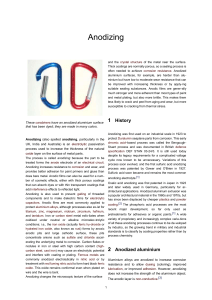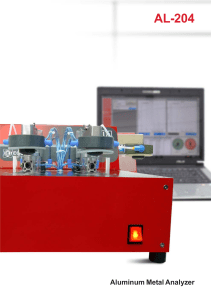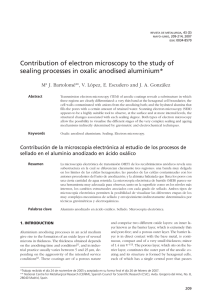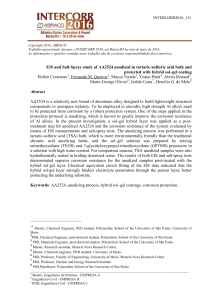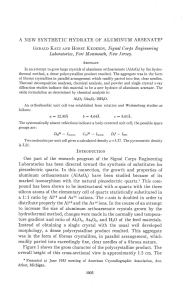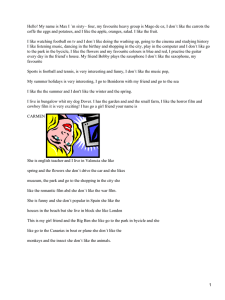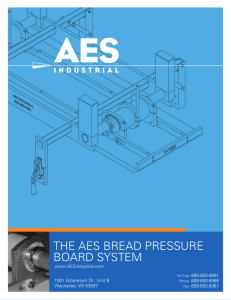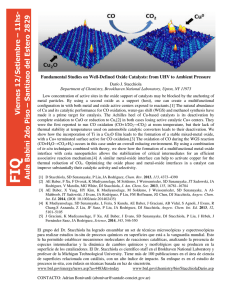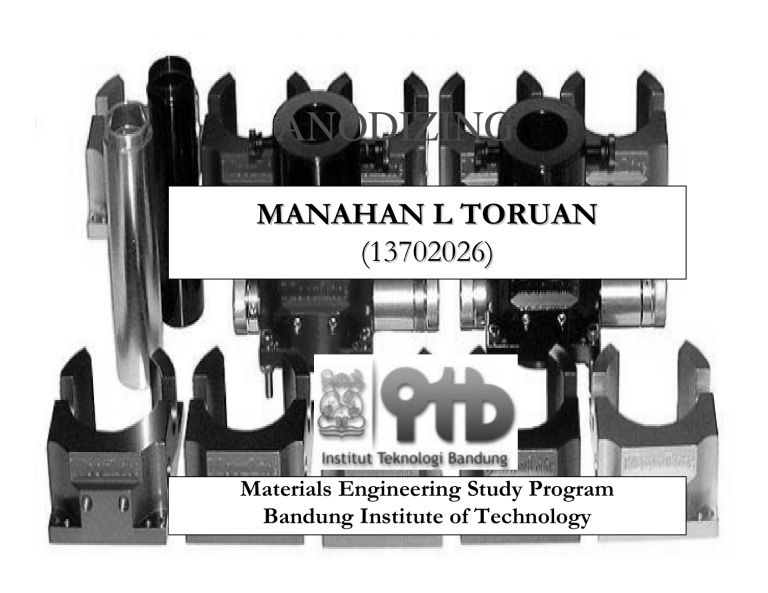
ANODIZING • • • • • • • • • What is Anodizing The purpose of Anodizing Reaction in Anodizing Process Characteristic of Anodizing Anodizing Benefit Anodizing Method Type of Anodizing Anodizing Process Application What is Anodizing ? • Anodizing is the successful development and control of a natural oxidation process that occurs when aluminum is exposed to the atmosphere Reaction in Anodizing Process • Anode Reaction – Reaction at Metal/Oxide 2Al + 3O2- Al2O3 + 6e- – Reaction at Oxide/Electrolyte 2 Al (metal) + 3H2O Al2O3 (oxide coating) + 6H+ + 6e- – Total reaction in anode 2Al 2Al3+ + 6e- • Cathode Reaction 6H+ + 6e- 3H2 (gas) Reaction (cont’d) • Total Reaction in anodizing process 2Al(metal) + 3H2O 3H2 Al2O3 + The purpose of Anodizing • The purpose of anodizing is to form a layer of aluminum oxide that will protect the aluminum beneath it Characteristic of Anodizing • • • • • Hard, comparable to sapphire Transparent, similar to glass Insulative and static resistant Wide variety of colors and finishes Integral with aluminum surfaces, nonflaking Anodizing Benefit • • • • • • Durability Color stability Ease to maintenance Aesthetics Cost Health and Safety Anodizing can improves the properties of aluminum : • Corrosion resistance A low porosity of oxide film will have good resistance against pitting, galvanic and general corrosion • Wear Resistance • Surface Hardness Bright/Architectural Anodizing increases the surface hardness from 60-130 HV to value between 200-350 HV • Electrical Resistance • Fire Protection Anodic oxide layers give a minor increase in the fire protection of aluminum constructions. The melting point of the oxide surface increases from approximately 650°C to approximately 2000°C. Anodizing Method Continuous Coil Anodizing Sheet Anodizing Batch or Piece Anodizing Uses High volume Coiled sheet Foil Products with less severe forming. Uses Wide widths Plate Large fabricated products. Uses Extrusions Castings Parts with severe forming Advantages Wide range of metal and film thicknesses Less material handling Precise color control and uniformity Cost effective Advantages Small runs Thicker films Anodized edges Advantages Small runs Thicker films Anodized edges Disadvantage Bare edges on stamped parts Crazing when severely formed Limited to sheet and foil Disadvantages Color variance High costs Film thickness variance Crazing when severely formed Disadvantages Color variance Excessive handling High costs *Coil anodizing involves continuous unwinding of coils through a series of anodizing tanks and then rewinding. *Sheet anodizing involves racking or framing of sheets and immersing them in large tanks. *Piece anodizing involves racking parts and immersing them in a series of treatment tanks Anodizing method (cont’d) ! ! " " " Type of Anodizing • Bright Anodizing • Hard Anodizing BRIGHT ANODIZING • Bright anodizing is a special type of anodizing (in combination with polishing) when glossy or shiny surfaces are required • To achieve both good abrasion resistance and good reflectivity an oxide coating thickness of approximately 10 µm is suitable • Application : Finishing trim components, automotive applications like window trims and bumpers HARD ANODIZING • Hard anodizing is a term used to describe the production of anodic coatings with film hardness or abrasion resistance as their primary characteristic • The hardness can achieved greater than 350 HV. Hardness values up to 1400 HV are reported to be obtained from a mixed electrolyte Hard Anodizing (cont’d) • Hard anodized aluminum shows a good heat resistance, and a hard anodic oxide coating of 75 µm withstands short exposures to temperatures of the order of 20000C • The coatings give also very good electrical insulation. • Application: In industry for components which require a very wear resistant surface such as pistons, cylinders, and hydraulic gear. Another application is in the coating for the production of flame and chemically resistant surfaces. ! Anodizing Process • Cleaning The Purposes: Removal of unwanted surface contamination. Prepare the surface for further processing. • Pretreatment Rinsing : Effectively terminate the previous reaction progress To remove all by-products and contaminants of the preceding stage Prevent cross contamination from one process with another Etching Etching is design to dissolve the surface aluminum so that we can achieve the following : Diminish extrusion die lines and mild scratch Develop a smooth, uniform finish Obtain a matte (diffuse) finish # $% – Deoxidizing & Desmutting Prepares the surface for subsequent finishing: Remove surface oxide Remove “smut”-which is combination of intermetallics, metal and metal oxide on the surface after cleaning/etching Activate surface • Anodizing Aluminum Anodizing is the electrochemical oxidation of an aluminum surface to produce a stable film oxide In this process a porous, insulative layer composed of aluminum and oxygen is produced by passing electricity through the aluminum in a conductive medium • Coloring This process is to enhance the appearance of the material and widen the application for anodized aluminum Current power used to deposit metal (Cu, Ni, Co etc) at the bottom of the pore. • Sealing Anodic Coatings The purpose of sealing an anodic coating is to close the pore structure of the anodic film and render the film inert The sealing process renders the film : Non-staining Non-absorbing Non-reacting Non-corroding Anodized Aluminum Applications • Structures and architectural categories of all types • Commercial and residential building products • Food preparation equipment • Furniture • Sporting goods and boats • Motor vehicle components • Building exteriors, such as storefronts, curtain walls and roofing systems. Thank You…..!
